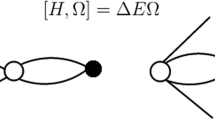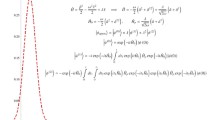Summary
Two methods of linearizing Hamiltonians which are quadratic in the relative momentum of the two interacting particles are considered. The first one satisfies Heisenberg’s equation of motion for the relative co-ordinate exactly, and yields a wave function which is similar to the solution obtained in the WKB approximation. The second one, due to Glauber is obtained directly from the quadratic Hamiltonian using the high-energy approximation. These Hamiltonians are used to calculate the scattering phase shifts for different partial waves. By expanding theT-matrix in terms of the weighted orthogonal polynomials and then relating the coefficients of this expansion to the corresponding coefficients in the partial-wave decomposition, a simple and yet accurate method of calculating theT-matrix is found. The result of a numerical computation indicates that the first method of linearization is reliable at intermediate energies for all angles, while the second method is accurate for high energies and small scattering angles.
Riassunto
Si considerano due metodi di linearizzare gli hamiltoniani che sono quadratici nell’impulso relativo delle due particelle interagenti. Il primo soddisfa esattamente l’equazione del moto di Heisenberg per la coordinata relativa, e produce una funzione d’onda che è simile alla soluzione ottenuta nell’approssimazione di WKB. Il secondo, dovuto a Glauber, si ottiene direttamente dall’hamiltoniano quadratico usando l’approssimazione di alta energia. Questi hamiltoniani sono usati per calcolare gli spostamenti di fase dello scattering per diverse onde parziali. Sviluppando la matriceT in termini dei polinomiali ortogonali pesati e quindi mettendo in relazione i coefficienti di questo sviluppo con i corrispondenti coefficienti nella decomposizione delle onde parziali, si trova un metodo semplice e tuttavia accurato per calcolare la matrice.T. Il risultato del calcolo numerico indica che il primo metodo di linearizzazione è attendibile a energie intermedie per tutti gli angoli, mentre il secondo metodo è accurato per le alte energie e per piccoli angoli di scattering.
Резюме
Рассматриваются два метода линеаризации Гамильтонианов, которые являются квадратичными но относительному импульсу взаимодействующих частиц. Первый метод удовлетворяет гайзенберговскому уравнению движения для относительной координаты. Этот метод дает волновую функцию, которая аналогична решению, полученному в квазиклассическом приближении. Второй метод, предложенный Глаубером, получается непосредственно из квадратичного Гамильтониана, используя приближение высоких энергий. Эти Гамильтонианы используются для вычисления фазовых сдвигов рассеяния для различных парциальных волн. РазлагаяT-матрицу по взвешенным ортогональным полиномам, а затем связывая коэффициенты этого разложения с соответствующими коэффициентами разложения по парциальным волнам, мы получаем простой и точный метод для вычисленияT-матрицы. Результат численного расчета указывает, что первый метод линеаризации является более удобным при средних энергиях для всех углов, тогда как втпрой метод является надежным для высоких энергий и малых углов рассеяния.
Similar content being viewed by others
References
See, for instance,L. S. Rodberg andR. M. Thaler:Interoduction to the Quantum Theory of Scattering (New York, N. Y., 1967), p. 55.
T. A. Osborn:Ann. of Phys.,58, 417 (1970).
M. Razavy:Can. Journ. Phys.,50, 2037 (1972).
R. J. Glauber: inLectures in Theoretical Physics, edited byW. E. Brittin andL. G. Dunham (New York, N. Y., 1959).
D. R. Harrington:Phys. Rev.,184, 1745 (1969).
H. Brysk:Journ. Math. Phys.,6, 51 (1965).
M. Razavy andR. Teshima:Nucl. Phys.,235 A, 278 (1974).
Author information
Authors and Affiliations
Additional information
Supported in part by the National Research Council of Canada.
Traduzione a cura della Redazione
Перевебено ребакцией.
Rights and permissions
About this article
Cite this article
Razavy, M., Salevsky, F.C. Approximate method of calculating the transition matrix using linearized Hamiltonians. Nuov Cim B 33, 508–518 (1976). https://doi.org/10.1007/BF02723883
Received:
Published:
Issue Date:
DOI: https://doi.org/10.1007/BF02723883




